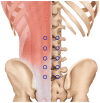Effectiveness of Acupotomy Combined with Epidural Steroid Injection for Lumbosacral Radiculopathy: A Randomized Controlled Pragmatic Pilot Study
- PMID: 38276054
- PMCID: PMC10818306
- DOI: 10.3390/medicina60010175
Effectiveness of Acupotomy Combined with Epidural Steroid Injection for Lumbosacral Radiculopathy: A Randomized Controlled Pragmatic Pilot Study
Abstract
Background and Objectives: This pilot study aimed to evaluate the clinical effectiveness, cost-effectiveness, and safety of acupotomy combined with epidural steroid injection (ESI) in lumbosacral radiculopathy and examine its feasibility for the main study. Materials and Methods: This randomized, controlled, two-arm, parallel, assessor-blinded, pragmatic study included 50 patients with severe lumbosacral radiculopathy who had insufficient improvement after an ESI. Patients were randomized (1:1 ratio) into a combined treatment (acupotomy + ESI, experimental) and an ESI single treatment (control) group. Both groups underwent a total of two ESIs once every 2 weeks; the experimental group received eight additional acupotomy treatments twice a week for 4 weeks. Types of ESI included interlaminar, transforaminal, and caudal approaches. Drugs used in ESI comprised a 5-10 mL mixture of dexamethasone sodium phosphate (2.5 mg), mepivacaine (0.3%), and hyaluronidase (1500 IU). The primary outcome was the difference in changes from baseline in the Oswestry Disability Index (ODI) scores between the groups at weeks 4 and 8. The incremental cost-utility ratio (ICUR) was calculated to evaluate the cost-effectiveness between the groups. Adverse events (AEs) were assessed at all visits. Results: Mean ODI scores for the experimental and control groups were -9.44 (95% confidence interval [CI]: -12.71, -6.17) and -2.16 (95% CI: -5.01, 0.69) at week 4, and -9.04 (95% CI: -12.09, -5.99) and -4.76 (95% CI: -7.68, -1.84) at week 8, respectively. The difference in ODI score changes was significant between the groups at week 4 (p = 0.0021). The ICUR of the experimental group versus the control group was as economical as 18,267,754 won/quality-adjusted life years. No serious AEs were observed. Conclusions: These results demonstrate the potential clinical effectiveness and cost-effectiveness of acupotomy combined with ESI for lumbosacral radiculopathy and its feasibility for a full-scale study. Larger, long-term follow-up clinical trials are needed to confirm these findings.
Keywords: acupotomy; epidural steroid injection; integrative medicine; pilot projects; radiculopathy; randomized controlled trial.
Conflict of interest statement
The authors declare no conflicts of interest. The funders had no role in the design of the study, in the collection, analysis, or interpretation of data, in the writing of the manuscript, or in the decision to publish the results.
Figures



References
-
- Kartha S., Ghimire P., Winkelstein B.A. Inhibiting Spinal Secretory Phospholipase A2 After Painful Nerve Root Injury Attenuates Established Pain and Spinal Neuronal Hyperexcitability by Altering Spinal Glutamatergic Signaling. Mol. Pain. 2021;17:17448069211066221. doi: 10.1177/17448069211066221. - DOI - PMC - PubMed
Publication types
MeSH terms
Substances
Grants and funding
LinkOut - more resources
Full Text Sources
Medical

